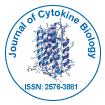Short Note on Role of Dendritic Cells
Received: 08-Jan-2022 / Manuscript No. . jcb-22- 52699 / Editor assigned: 10-Jan-2022 / PreQC No. jcb-22- 52699 / Reviewed: 24-Jan-2022 / QC No. jcb-22- 52699 / Revised: 26-Jan-2022 / Manuscript No. jcb-22- 52699 / Accepted Date: 26-Jan-2022 / Published Date: 02-Feb-2022 DOI: 10.4172/2161-0681.1000062
Opinion
The immune system is in charge of protecting the host against a wide range of possible infections while also avoiding immune reactivity towards self-components. Immune checkpoints are critical for managing the immunity/tolerance balance; self-tolerance must be firmly maintained throughout various central and peripheral processes.
Dendritic cells are antigen-capturing cells that either activate or suppress antigen-specific T lymphocytes. As a response, they serve a crucial role in the development and maintenance of immunological tolerance. Tolerogenic dendritic cells are DCs that suppress the immune response. Vaccine effectiveness is complicated by the intricacy of numerous dendritic cell subsets in skin tissues, each of which expresses different glycan-binding receptors that can mediate vaccine absorption or vaccine drainage via lymphatics directly to lymph node– resident dendritic cell.
Furthermore, the presence of inflammatory immune cells at the vaccination site, such as monocytes that develop into dendritic cell and co express glycan-binding receptors, may enhance the efficacy of DC-targeting glycol vaccines in the future. Fusion cells of tumor cells and dendritic cells are a promising immunotherapeutic technique, although they are currently underutilized in cancer treatment clinical trials. We established a novel strategy for fusing dendritic cells with MDA-MB-231 cells expressing the heterologous-galactose epitope and examined its anticancer properties to further increase their anticancer efficiency. Malondialdehyde coupled with human serum albumin was used to differentiate human dendritic cells from blood monocytes. Autologous T cells were co-cultured with pre-treated dendritic cells or treated directly from human plaques or blood. Dendritic cells are becoming increasingly significant in research and therapeutic practise, yet getting sufficient quantities of dendritic cell is becoming increasingly difficult. In Micro DEN, a perfusion-based culture system, as well as 6-well plates, we studied the influence of monocyte seeding density on the development of monocyte-derived immature. Dendritic cell therapy’s therapeutic efficacy must be improved.
Exosomes are membrane Nano-vesicles that contain biomacromolecules and are important in intercellular communication. Exosomes produced from tumour cells could be used to deliver exogenous miRNA-155 to They can be found in a variety of tissues and organs. The retina’s peripheral borders and juxtapapillary portions contain resident ocular DCs, which are normally immature. Dendritic cell are activated during inflammation and play a role in the development of uveitis, an eye inflammatory illness. Vaccine adjuvants, medication delivery, immunotherapy, cell transplantation, tissue engineering, and regenerative medicine all benefit from strategies that increase, suppress, or qualitatively change immune responses. However, a lack of understanding of how these biomaterial systems interact with complicated host microenvironments, such as increased foreign body reaction and immune toxicity, has a negative impact on their clinical efficacy. In line with previous findings that HHV- 6B disrupted autophagy and caused endoplasmic reticulum stress in cells where it replicated, we discovered that these effects also occurred in differentiating monocytes, and that relieving ER stress with the chemical chaperone sodium 4-phenylbutirate partially restored dendritic cell formation.
This shows that the immunological suppression caused by HHV- 6B produced from exanthema sub item patients may be enhanced by the production of ER stress, which is likely exacerbated by autophagy inhibition. Due to their unique ability to start T cell responses and direct their development into effector lineages, dendritic cells play a vital role in orchestrating adaptive immune responses. Based on phenotypic indicators and their ability to excite CD8 and CD4 T cells, classical DCs have been split into two subgroups, cDC1 and cDC2 [1-5].
References
- Wang L, Wang Li, Bai M, Wang J, Zhang Z (2014) Blastic plasmacytoid dentritic cell neoplasm:two cases report and literature review. 35: 1124-1126.
- Thind SK, Taborda CP, Nosanchuk JD (2015) Dendritic cell interactions with Histoplasma and Paracoccidioides. Virulence 6: 424-432.
- Han J, Li Y, Wang P J, Shi CL, Ding B et al. (2017) Blastic plasmacytoid dentritic cell neoplasm with myeloproliferative neoplasms:a case report . 38: 256.
- Brok M, Nierkens S, Figdor CG, Ruers TJ, Adema GJ (2005 ) Dendritic cells: tools and targets for antitumor vaccination. 4:699-710.
- Collin M, Ginhoux F (2019) Human dendritic cells. Semin Cell Dev Biol 86: 1-2.
Indexed at, Google Scholar, Crossref
Indexed at, Google Scholar, Crossref
Indexed at, Google Scholar, Crossref
Indexed at, Google Scholar, Crossref
Citation: P (2022) Short Note on Role of Dendritic Cells. J Cytokine Biol 7: 062. DOI: 10.4172/2161-0681.1000062
Copyright: © 2022 Sharma P. This is an open-access article distributed under the terms of the Creative Commons Attribution License, which permits unrestricted use, distribution, and reproduction in any medium, provided the original author and source are credited.
Share This Article
Recommended Journals
Open Access Journals
Article Tools
Article Usage
- Total views: 1728
- [From(publication date): 0-2022 - Mar 31, 2025]
- Breakdown by view type
- HTML page views: 1204
- PDF downloads: 524
